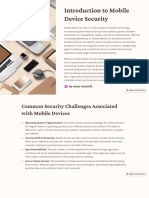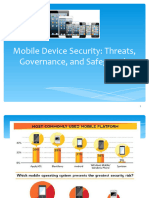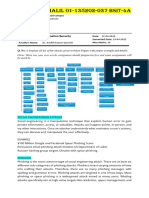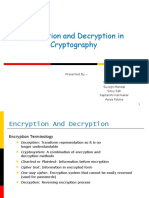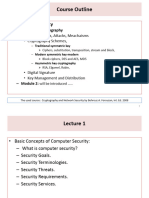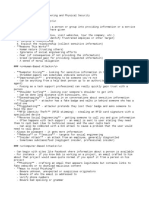MOBILE SECURITY
INTERVIEW
QUESTIONS &
ANSWERS
Prepared by HANIM EKEN
https://ie.linkedin.com/in/hanimeken
https://ie.linkedin.com/in/hanimeken
� 1. What is mobile security, and why is it important in the context of mobile
applications and devices?
Mobile security refers to the measures and practices taken to protect mobile devices,
applications, and data from various security threats. It is essential because mobile devices are
highly susceptible to security risks due to their portability and the vast amount of sensitive data
they often handle. Mobile security is crucial to safeguard user data, prevent unauthorized
access, and protect against mobile-specific threats like app tampering and data interception.
2. What are some common mobile security threats that users and developers should
be aware of?
Common mobile security threats include:
Malware and Viruses: Malicious software designed to compromise device security and
steal data.
Unsecure Wi-Fi Networks: Using unsecured public Wi-Fi can expose users to data
interception and man-in-the-middle attacks.
App Spoofing and Tampering: Attackers may modify legitimate apps to distribute
malware or gather sensitive information.
Phishing Attacks: Users may receive deceptive messages or emails to trick them into
revealing personal information.
Lost or Stolen Devices: Unauthorized access to a lost or stolen device can lead to data
breaches and privacy issues.
3. What security measures should be implemented in mobile applications to protect
user data and privacy?
To protect user data and privacy, mobile applications should:
Use Secure Authentication: Implement strong authentication mechanisms like
biometrics or two-factor authentication to ensure only authorized users can access
sensitive data.
Encrypt Data: Encrypt sensitive data both in transit and at rest to prevent unauthorized
access.
Apply Secure Coding Practices: Follow secure coding standards to avoid common
vulnerabilities like injection attacks and buffer overflows.
Regularly Update Apps: Ensure that apps receive regular security updates and patches
to address known vulnerabilities.
Implement App Permissions: Request user permission only for necessary
functionalities and data access.
4. How do you ensure secure communication between mobile devices and servers?
To ensure secure communication between mobile devices and servers, I use the following
methods:
https://ie.linkedin.com/in/hanimeken
� Transport Layer Security (TLS): Implement TLS encryption to secure data transmission
over the internet.
Certificate Pinning: Pinning server certificates to prevent man-in-the-middle attacks.
Secure APIs: Use secure APIs with authentication and authorization mechanisms to
restrict access to sensitive data.
Data Validation: Validate and sanitize data received from mobile devices to prevent
injection attacks.
5. What steps do you take to keep up-to-date with the latest mobile security threats
and best practices?
To stay up-to-date with mobile security threats and best practices, I regularly:
Follow Security Research: Monitor security news and research from reputable sources
and organizations.
Attend Security Conferences: Participate in mobile security conferences and workshops
to learn from experts in the field.
Engage in Security Forums: Participate in online security forums and communities to
exchange knowledge and insights.
Review Security Advisories: Stay informed about security advisories and updates from
mobile operating system vendors.
6. How do you handle security incidents or breaches involving mobile devices or
applications?
In the event of a security incident or breach, I follow these steps:
Containment: Isolate the affected devices or applications to prevent further damage.
Investigation: Determine the scope and cause of the incident through thorough
investigation.
Notification: Notify relevant stakeholders, including users, if necessary, about the
incident and its impact.
Remediation: Address the root cause of the incident and fix vulnerabilities to prevent
future occurrences.
Communication: Communicate the incident response and resolution plan to the
appropriate parties, including management and affected users.
7. What are some common security threats faced by mobile devices, and how do you
address them?
Common security threats faced by mobile devices include:
Malware: Utilizing mobile antivirus and security applications to detect and remove
malicious software.
Phishing Attacks: Educating users about recognizing and avoiding suspicious links and
emails.
Unsecured Wi-Fi: Encouraging the use of secure Wi-Fi connections and avoiding
public Wi-Fi networks for sensitive transactions.
Lost or Stolen Devices: Implementing remote wipe and device tracking capabilities to
protect data if a device is lost or stolen.
https://ie.linkedin.com/in/hanimeken
� 8. How do you secure mobile applications against potential security vulnerabilities?
To secure mobile applications against vulnerabilities, I employ the following practices:
Secure Coding: Utilize secure coding practices to prevent common vulnerabilities like
SQL injection and Cross-Site Scripting (XSS).
Encryption: Implement strong encryption for sensitive data in the application and
during data transmission.
Code Review: Conduct regular code reviews to identify and fix security flaws during
the development process.
Penetration Testing: Perform penetration testing to identify and address potential
weaknesses in the application.
9. What measures do you take to protect mobile devices from malware and other
security threats?
To protect mobile devices from malware and security threats:
Install Security Apps: Encourage users to install reputable antivirus and security
applications on their devices.
Keep Software Updated: Prompt users to regularly update their device's operating
system and applications.
Educate Users: Conduct security awareness training to educate users about potential
threats and safe online behavior.
App Whitelisting: Implement app whitelisting to allow only approved applications to
run on corporate devices.
10. How do you protect a mobile application against reverse engineering and
tampering?
To protect a mobile application against reverse engineering and tampering:
Code Obfuscation: Obfuscate the code to make it harder for attackers to understand and
reverse engineer.
Root/Jailbreak Detection: Implement checks to detect if the device is rooted (Android)
or jailbroken (iOS).
Integrity Checks: Implement integrity checks to detect tampering attempts and respond
accordingly.
Secure API Usage: Use API keys and secure token handling to prevent unauthorized
access to APIs.
https://ie.linkedin.com/in/hanimeken













































